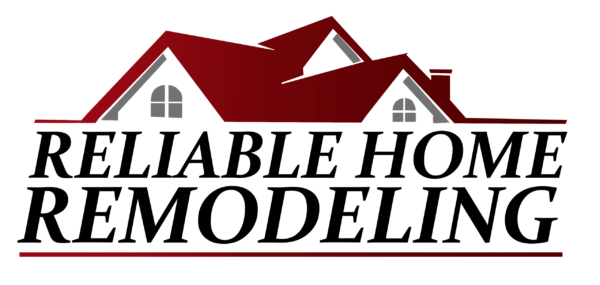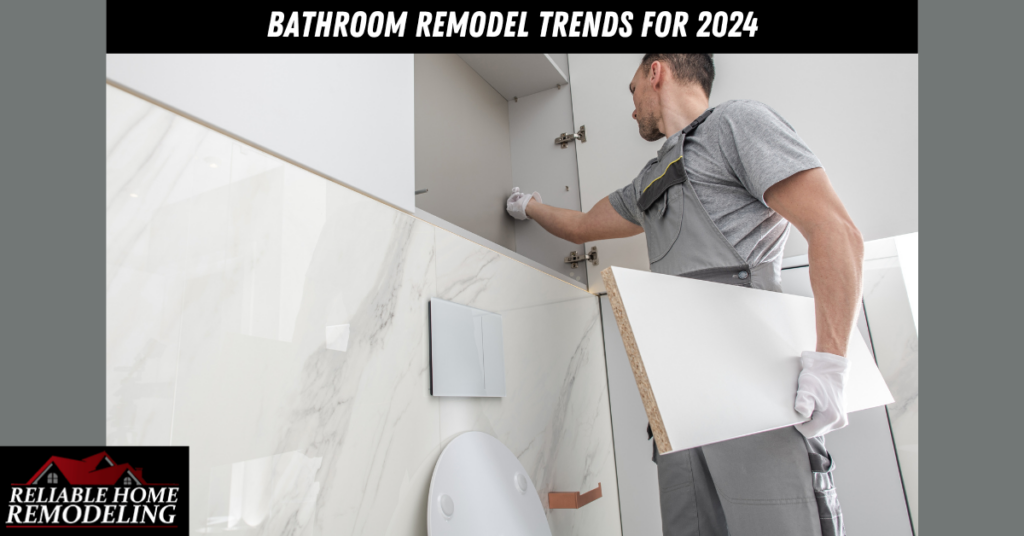The year is coming to an end and while you might be busy with Holiday plans that doesn’t mean you can’t start thinking about building that dream bathroom you’ve always wanted. Picture yourself enjoying a relaxing bath in a newly renovated spa like oasis. What would this space look like? What colors would you want to see? What features would you want in this bathroom? In this article we will cover 6 bathroom remodel trends for 2024 to give you inspiration and ensure you’re up to date with the latest styles.
6 Bathroom Remodel Trends For 2024
See how you can incorporate the following bathroom remodel trends to build that beautiful bathroom you’ve always wanted:
1. Colors, Materials And Textures That Reflect Nature
A nature themed bathroom brings a sense of serenity to an other wise dull room in the house. With the right combination of colors, textures and patterns you can bring the outdoors inside and create the feeling of being at a resort. Here are some ideas to consider:
- Earth Tones: Using a combination of rich browns, burnt orange and muted greens can mimic the look of nature
- Organic Materials: Use materials like wood, stone and bamboo to complement the colors mentioned above.
- Greenery: Use plants to accessorize your bathroom. This will not only go with the nature theme but it also purifies the air.
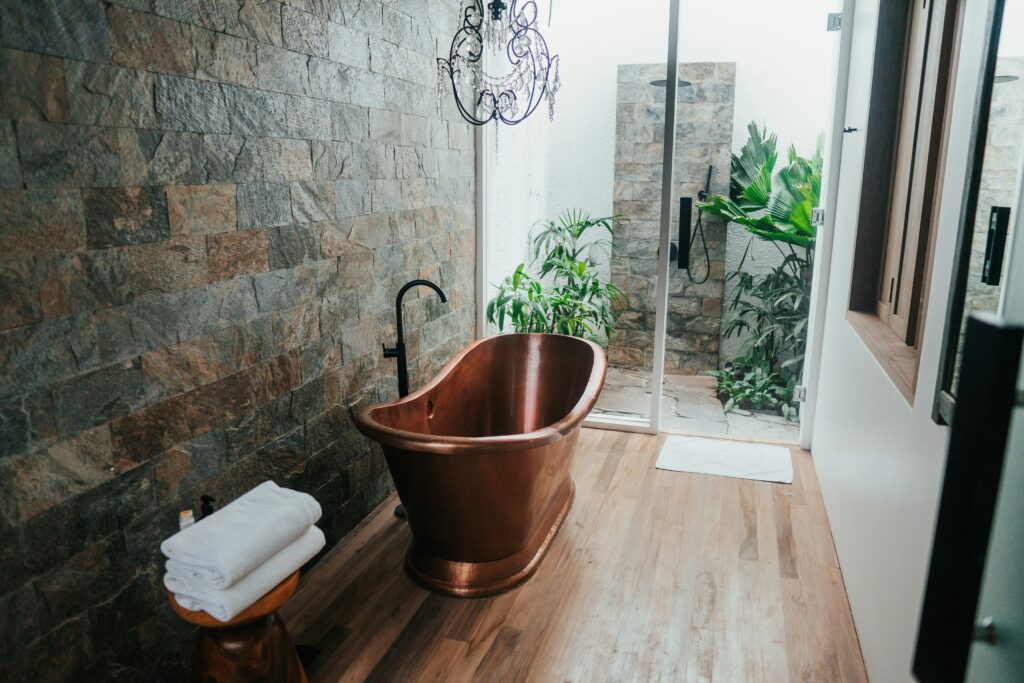
2. Sustainable And Eco-Friendly Features
Sustainability is not just a buzzword thrown around for marketing purposes, every industry has to make an effort to play their role in taking care of the environment. Having sustainable and eco friendly features is definitely one of the more popular bathroom remodel trends to follow. There are three main areas to look into when it comes to making your bathroom eco-friendly:
- Energy Efficiency
- Sustainable Materials
- Water Conservation
Energy Efficiency
Water Heater: A good percentage of the energy you use in your home is for heating water. Even though the water heater might not be in the bathroom by replacing it with a more efficient model is a step in making your bathroom eco-friendly. Keep an eye open for the EPA’s ENERGY STAR logo, this lets you know that the product has been certified and could potentially make you eligible for federal tax credits. Here are some options to consider:
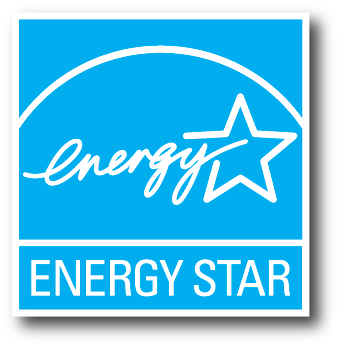
- Heat Pump Water Heater – A cutting-edge and highly efficient alternative, this system operates like a reverse air conditioner. It extracts heat from the air, using it to heat refrigerant that, in turn, warms your water. These electric systems surpass the efficiency of gas water heaters and are suitable for both new constructions and retrofits. Some models even utilize CO2 as a refrigerant, offering a safer option for the ozone layer.
- Tankless Water Heater – Unlike traditional water heaters that store water, tankless water heaters heat water on demand. Consumer Reports found that gas tankless water heaters consume 22 percent less energy than their conventional gas storage counterparts.
- Condensing Storage Water Heater – Boasting up to 96 percent efficiency, these water heaters closely resemble conventional units but operate differently. Instead of losing heat through venting, condensing storage water heaters capture exhaust and channel it through heat coils inside the unit, generating more hot water with less energy.
- Solar Water Heater – Capable of reducing water heating energy costs by 50 percent, solar water heaters harness the sun’s energy, making them environmentally friendly. Suitable for any climate, these systems, although requiring a backup for cloudy days, offer a cost-effective, long-term solution.
Exhaust Fan: The latest exhaust fans with ENERGY STAR certification consume less electricity, operate more quietly, incorporate humidity sensors for optimal performance, and efficiently clear the air. This not only prevents mirrors from fogging up but also safeguards against the potential damage caused by humidity, such as the promotion of mold growth. Ensure that the fan is vented outside the home rather than into the attic to enhance the overall air quality throughout your residence.
Lighting: Opting for natural light is undeniably the most energy-efficient choice. Explore the possibility of incorporating a skylight or solar tube, and contemplate the use of glass block for exterior walls to allow light in while maintaining privacy. When it comes to installing light fixtures, rely on the ENERGY STAR logo as your top reference for discovering the most energy-efficient options. Their certified LED lights, for instance, conserve 90 percent more energy than traditional bulbs and have a lifespan up to 25 times longer.
Sustainable Materials
Ceramic: Ceramic is a great eco-friendly alternative to other material such as plastic, vinyl and laminate. Here are some of the environmental benefits of ceramic:
- It is manufactured using natural elements which makes it completely recyclable.
- Efficient manufacturing process reduces energy consumption.
- Ceramic tiles are not burnt or melted and, therefore, they do not emit toxic gases.
- Pollution during the supply is minimal, since the factories are close to the sources of raw materials.
- High resistance and durable material that reduces the need for excessive consumption of resources.
Steel: Steel is actually one of the most eco-friendly building materials. More steel is recycled than paper, aluminum, plastic and glass combined. Unlike other materials such as wood or plastic steel can be reused infinitely once it is produced. This makes it not only environmentally conscious but also economically strategic because of its durability and longevity. Consider having all steel fixtures in your new bathroom.
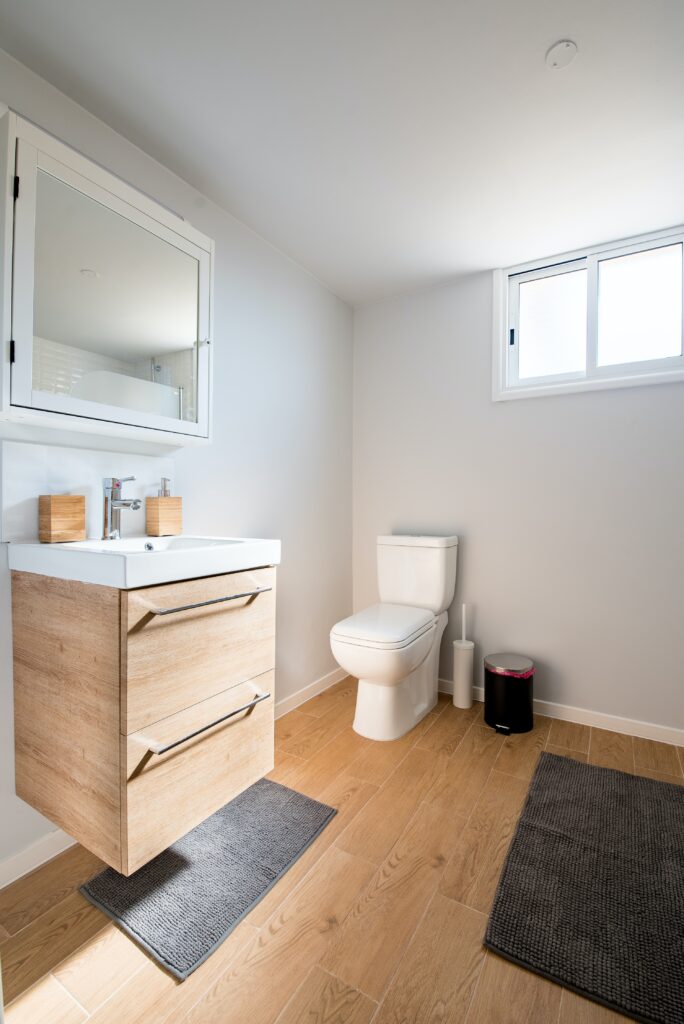
Bamboo: Bamboo is a sustainable, highly renewable, and eco-friendly material perfect for bathroom remodels. Due to it’s rapid growth taking just a few years to mature bamboo makes a great alternative to hardwood trees which could take up to decades. In addition bamboo is also biodegradable and can absorb carbon dioxide from the atmosphere. Due to it’s versatility there are endless ways to use bamboo but here are some common uses for your bathroom:
- Accessories such as soap dishes, tooth brushes, bath mats, stands, benches and trash bins.
- Mirrors and mirror cabinets.
- Flooring
- Storage containers
- Live bamboo plants
Brass: Just like steel, brass has the same ability to be reused infinitely after production. It is more efficient to recycle brass than it is to mine for raw materials and produce new brass. Some great uses for brass in bathroom remodeling are:
- Lighting fixtures
- Outer frames on shower doors, mirrors and outlets
- Faucets, showerheads and taps
- knobs on draws and doors
Reclaimed Wood: Reclaimed wood can be sourced from a number of places including:
- Old structures not in use such as buildings, bridges, fencing, dunnage, and bleacher seating.
- Scrap wood from factories.
- Water reclaimed wood from reservoirs
- Left over wood from timber cutting
- Old wood from orchards
The procurement and transportation of reclaimed wood are both environmentally friendly, helping to avoid unnecessary deforestation. Utilizing reclaimed wood also guarantees that unused timber doesn’t contribute to landfill waste.
Water Conservation
Toilets: According to the EPA, a standard toilet typically consumes 1.6 gallons per flush, whereas an older model might be utilizing anywhere from 3.5 to 7 gallons per flush. An old toilet with a leak can squander up to 200 gallons each day! For environmentally conscious individuals, a dual flush toilet stands out as the optimal choice for water conservation. The dual flush mechanism allows you to use 1.6 gallons for a full flush or approximately half of that for liquid waste. Some of these toilets incorporate vacuum technology for a robust flush, further reducing water consumption. There’s even a unique toilet design featuring a sink mounted over the tank, where the water used for handwashing doubles as the flush for the next use! Regardless of your preference, be sure to look for the EPA’s WaterSense label to verify that the product aligns with its water-saving claims.
Showerheads: A typical showerhead consumes 2.5 gallons of water per minute, but those manufactured before 1992 may have a higher flow rate of up to 5.5 gallons per minute. To determine your showerhead’s flow rate, place a marked bucket in the shower, run the water for one minute, and measure the accumulated water volume. There are two types of low-flow showerhead options to choose from:
- Aerating: Combines air with water for a misty spray.
- Laminar Flow: Directs water into individual streams.
These options maintain performance while conserving water. Innovative technologies, such as water-recycling showers, have also emerged, enabling consistent water use regardless of shower duration and reducing consumption by up to 90%. Look for the EPA’s WaterSense label when making a selection.
Faucets: Bathroom sink faucets with the WaterSense label utilize a maximum of 1.5 gallons per minute, achieving a water reduction of 30 percent or more compared to the standard flow rate of 2.2 gallons per minute. This efficient design maintains optimal performance. Additionally, incorporating an aerator further limits the water flow to just 0.5 gallons per minute.
Greywater Systems: Greywater refers to gently used water originating from bathroom sinks, showers, tubs, and washing machines. It excludes water that has been in contact with feces, whether from toilets or diaper washing. Although greywater may contain traces of dirt, food, grease, hair, and certain household cleaning products, it is considered a safe and beneficial source for irrigating yards. Implementing intelligent irrigation systems and redirecting greywater from your home can contribute to maintaining a lush and environmentally friendly yard.
3. Fancy Showers
People don’t want boring standard showers anymore, they are looking for a sense of luxury. Here are some features you can add to make your shower more fancy:
- Built-in seating
- Hand-held shower head
- Rain shower
- Steam shower
- Doorless shower space
- Clear glass panel with no framing
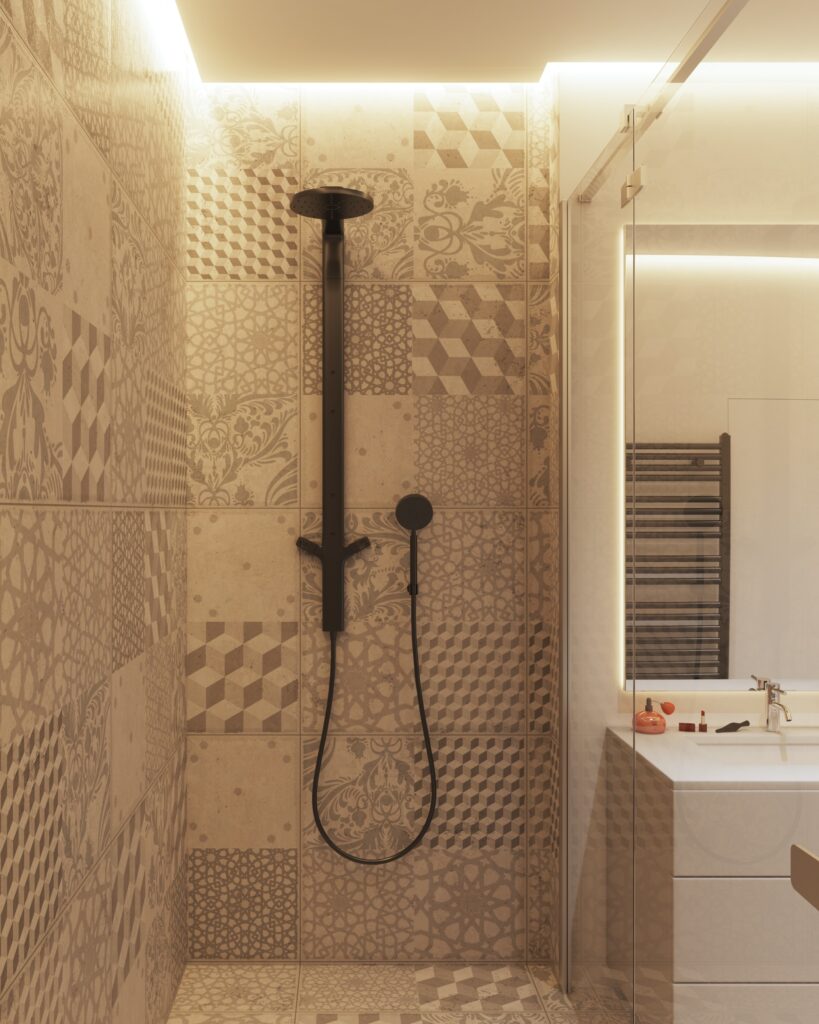
4. Artistically Patterned Tiles
Tiles are transcending their traditional functional purpose and establishing themselves as artistic elements in bathroom decor. Whether it’s an intricately designed backsplash or a bold floor choice, imaginative tiles play a crucial role in shaping the visual appeal of a bathroom. Artistic tiles can be used in subtle ways to complement your color palette, proving that impactful designs don’t necessarily require vibrant or colorful elements.
5. Wall Paper
Bathroom wall paper is a rising trend that is not going away any time soon. It serves as a great way to incorporate statement colors and often serves as a better alternative to wall paint or hanging up artwork. Pick an artistic design that adds a sense of luxury and personality to your bathroom. With the right wall paper design you can really bring out the look you are going for whether it is a nature themed, sleek and modern or luxurious.
6. Lighting
Similar to tiles, lighting is becoming more than just a functional feature. It has become one of the more popular bathroom remodel trends. With the advancements in technology lighting can be used to create a customized ambiance. The upcoming year will showcase creative light designs to enhance the aesthetic of the bathroom. A few trends to consider are:
- Customizable mood lighting
- Ornate chandeliers
- Backlit mirrors
- Vanity lighting
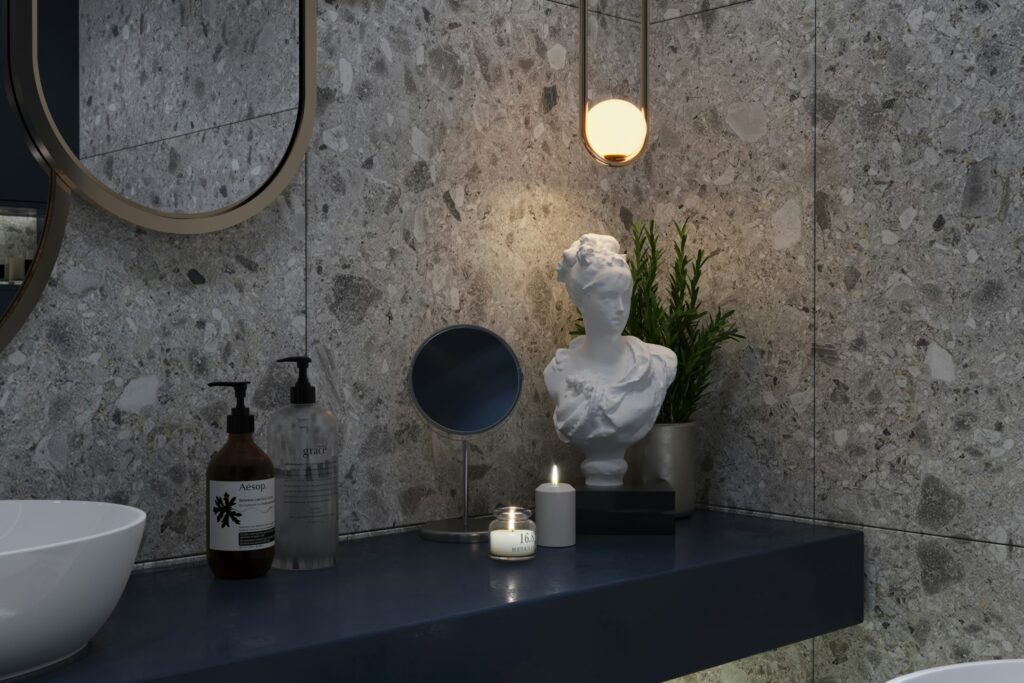
Conclusion
Now is the best time to get a head start on planning your bathroom remodel project for 2024. Using the Bathroom Remodel Trends we covered in this article as a guide you should be able to build the perfect bathroom customized to your needs and design preference. If you would like to learn more about the remodeling trends for 2024 give us a call at 631-530-1515, Reliable Home Remodeling is here to help!
